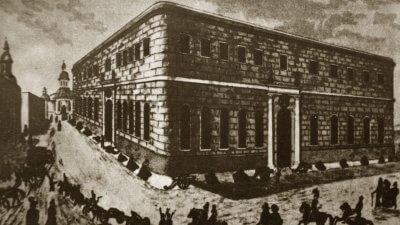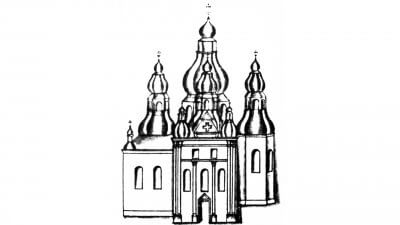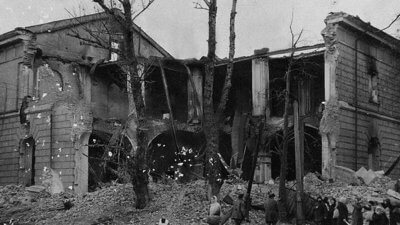MYSTETSKYI ARSENAL HISTORY
‘Mystetskyi Arsenal’ National Culture, Arts and Museum Complex is located in Pechersk – one of the three ancient historical parts of Kyiv. For centuries, it has been associated with the Sviato-Uspenskyi (Holy Assumption) Kyiv-Pechersk Monastery founded back in 1051. Olha Krainia considers that starting from the 1540s there was a female monastic community within the Monastery structure. The earliest mention of Voznesenskyi (Ascension) Pechersk monastery was recorded in ‘Virtues Pattern’ – the panegyric to Yelysei Pletenetskyi, archimandrite of the Pechersk Lavra. Mariia Mazepyna (Mariia Magdalyna in her ascetic life) was the Voznesenskyi Monastery’s hegumeness in 1688–1707. Thanks to the patronage of her son, hetman Ivan Mazepa, the Voznesenskyi Monastery reached its true height. Mariia Magdalyna covered the costs of Monatery renovations: a majestic stone five-headed cathedral with three thrones and a bell tower instead of the wooden Voznesenska Church, as well as the Protection of the Virgin Church. Both were erected in 1701–1705.
|
|
|
Left: Pechersk township, Uspenskyi [Assumption] and Voznesenskyi [Ascention] monasteries on A. Kalnofoskyi city plan. 1638
Right: Voznesenskyi [Ascention] cathedral, early 18th cent. Drawing from Friedrich Wilhelm von Bergholz collection. Stockholm archives
Later the building of the Kyiv-Pechersk Fortress started, thus Voznesenskyi Monastery was abolished, and its nuns were moved to the Florivskyi Monastery on Podil in 1711–1712. However, both churches continued to function as parochial and were dismantled in 1798 when the Arsenal building construction started. Recent archaeological excavations in the Arsenal inner courtyard revealed the remains of the Voznesenska Church foundations and a significant burial complex.

The Arsenal building – a former workshop for the manufacture, repair, storage of ammunition and cannonry – is the architectural dominant of the complex. Russian Empress Catherine II signed the decree on constructing the Arsenal building inside Pechersk Fortress in May 1783. In September of that year, Johann Shpekle, the architect of the Russian Army Corps of Engineers, developed the project of the Arsenal brick building. The military engineer Charles de Chardon started the construction works. They lasted until 1801 and were completed by Kyiv merchant Mykhailo Hryhorenko. The Arsenal building is unique: it’s the first Kyiv building of classicism style, built of yellow bricks without the use of external stitching. Thanks to the properties of local clay, these bricks acquired a yellow-amber hue, which gave reason for contemporaries to call it porcelain Arsenal.

The old Pechersk Fortress completely lost its defensive role early in the 19th century. It was transformed into a production and warehouse complex. During the following years, most of the entrance gates of the citadel were disassembled. Ramparts were cut for developing the streets, passages and even railroad tracks.
|
|
|
Left: Kyiv-Pechersk Fortress and Arsenal building. Aerophotography, 1930s
Right: Arsenal southwest corner. Aftermath of the explosion, World War II
The Arsenal complex with the adjoining territory received the status of an architecture and military engineering heritage-listed monument in 1979. It did not prevent from using the protected area for military and industrial needs until the early 21st century.
|
|
|
Inside the 61809 Military Unit. Second half of the 20th cent.
‘Mystetskyi Arsenal’ National Culture, Arts and Museum Complex was created on the initiative of the President of Ukraine Viktor Yushchenko, in accordance with the Order of the Cabinet of Ministers of Ukraine No. 49-r from March 3, 2005.
Entrance to the complex. 2005
|
|
|
Left: Arsenal interior before the start of restoration. 2005
Right: Restoration works. 2008
The National status was granted to Complex on February 3, 2010. The total area of the Complex is 9.8 hectares. Nowadays the conservation of premises goes simultaneously with the exhibitions organizing. The Arsenal is an institution of culture which integrates various types of arts: contemporary art, new music and theater, literature and museum affairs.
Left wing gallery of the Arsenal building, 2017. Photo: Roman Shalamov
In the long run, the Arsenal total exposition area will reach 60,000 sq.m.
Arsenal building, 2019. Photo: Oleksandr Popenko










